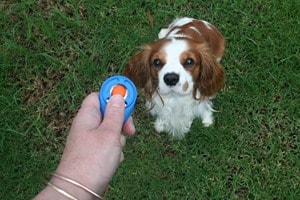There are many techniques you can use to teach your pet tricks or get them to act on their best behaviour. One technique that first gained popularity in marine animals is Clicker Training or Operant Conditioning. In the 1940’s this technique was used in a laboratory to study conditioning of man’s best friend, the dog. It was only made public with the use of marine animals to promote the effectiveness of the study and training method.
Today, there are many Clicker Training programs you can enroll your pet in. To know if you’re getting the real deal, here are some insights of what Clicker training is and is not.

Clicker Training uses the (click) as a behavioural marker to identify the moment your dog (or any pet) successfully responds as expected. For instance, if a dog can’t contain its energy and always lunges in excitement you would use a clicker to fix the problem. To rid the dog of this habit, a click trainer let’s the dog lunge then uses the click as soon as the dog’s four paws hit the floor…then a treat is given as an actual reinforcement. In essence it is the behavioural marker “CLICK” that needs to be enhanced.
On the contrary, lure-training-using-clicker is a rip-off version of Clicker Training. For the same sample dog behaviour, lure-trainers tutor the dog by putting the dog’s four paws on the floor after he lunges then “clicks” then gives a treat if the dog stays with four paws on the ground or the treat is strategically put on the floor. Lure training results in a robotic response because the treats are the markers. Compared to lure training, Clicker Training gives the trainer the ability to manipulate treat giving. Treats can be confidently given even if the dog doesn’t remain in the position because the behaviour has been marked by a click. Several runs of the simple procedure cures the frisky dog and at the same time has conditioned the dog to pay attention to the “CLICK” making it easier to add another skill for the dog like sitting or high five.
After rewarding your dog in position, a new step is introduced for the dog to repeat the position. So the dog gets rewarded in the improved step, gradually building up the dogs’ skill level. As opposed to lure training where in the dog is coaxed in between positions, making the dog treat focused and not behaviour-focused.
Just as in all training programs, there are limitations, which is inherent because of the intrinsic and instinctive nature of dogs. For example, trying to get an Irish setter to stop chasing game is trying to undo centuries of breeding characteristics. As a whole, Clicker Training is less stressful with only the “clicker” to aid in training. This is considered a comprehension instrument for dogs and contributes to behavioural norms. Dogs familiar with Clicker Training do routines without actual reinforcements, making them receptive to higher learning.
If you are interested in an effective way to train your pet, you should give clicker training a try. As with all training programs, patience and perseverance will play a key role in your success. One thing is for sure though; you and your pet will establish an excellent bond even if he doesn’t become the next dancing dog.
